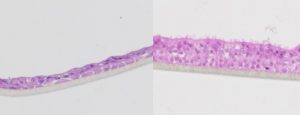
Professor Wojciech Chrzanowski
An Australian-led research team has developed in vitro models of healthy and diseased COPD lungs to facilitate the testing of potential new therapies for respiratory conditions.
The research, published in the journal Biomaterials Research [link here], said animal models cannot fully represent human lungs given their different anatomy, immune system, and inflammatory responses to drugs.
“Additionally, ethical and financial issues are raised in the use of animal models for testing drugs,” it said.
The research team, including senior investigator Professor Wojciech Chrzanowski from the University of Sydney Nano Institute, said current in vitro lung models also had limitations.
Professor Chrzanowski said in a statement that the new models more accurately emulate the complexities and dynamics of a human lung.
“We culture and maintain our models under the micro-environmental conditions of lungs, with air on one side and liquid interface at the bottom, combined with microcirculation…,” he said.
“We take cells directly from patients and then build them in layers as they exist inside the body. So, first you have the epithelial cells, then you have the fibroblasts – we are literally creating a mimic organ that is very much like actual human lungs.”

Diseased (left) and healthy membrane slivers from a lung organoid
The research article said advantageous features of their models include:
- microcirculation that maintains the physiological microenvironmental conditions,
- use of extracellular matrix peptides for substrate functionalisation, to promote the desired patho/physiological architecture and biomechanical properties of the tissue models, and
- use of patient-derived and relevant cells that enable the establishment of lung models for personalised medicine.
They said the lung models are likely to accelerate drug discovery and increase “the confidence on the safety, efficacy and superiority of new drugs and therapies.”
In addition, the lung-mimicking models can also be used to test lung toxicity and injury induced by inhaled pollution or pathogens.
Images courtesy of the University of Sydney.